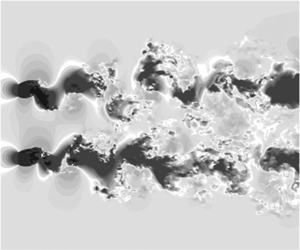Article contents
Energy transfer in turbulent flows behind two side-by-side square cylinders
Published online by Cambridge University Press: 18 September 2020
Abstract

Our previous study (J. Fluid Mech., vol. 874, 2019, pp. 677–698) confirmed that two different types of  $-5/3$ energy spectra (i.e. non-Kolmogorov and quasi-Kolmogorov
$-5/3$ energy spectra (i.e. non-Kolmogorov and quasi-Kolmogorov  $-5/3$ spectra) can be found in turbulent flows behind two side-by-side square cylinders. In the upstream region (i.e.
$-5/3$ spectra) can be found in turbulent flows behind two side-by-side square cylinders. In the upstream region (i.e.  $X/T_0=6$ with
$X/T_0=6$ with  $T_0$ being the cylinder thickness), albeit the turbulent flow is highly inhomogeneous and intermittent and Kolmogorov's hypothesis does not hold, the energy spectrum exhibits a well-defined
$T_0$ being the cylinder thickness), albeit the turbulent flow is highly inhomogeneous and intermittent and Kolmogorov's hypothesis does not hold, the energy spectrum exhibits a well-defined  $-5/3$ power-law range for over one decade. Meanwhile, the power-law exponent of the corresponding second-order structure function is 1, which is significantly larger than the expected value, i.e.
$-5/3$ power-law range for over one decade. Meanwhile, the power-law exponent of the corresponding second-order structure function is 1, which is significantly larger than the expected value, i.e.  $2/3$. At the downstream location, i.e.
$2/3$. At the downstream location, i.e.  $X/T_0=26$, in contrast, the quasi-Kolmogorov
$X/T_0=26$, in contrast, the quasi-Kolmogorov  $-5/3$ energy spectrum (and also the 2/3 scaling of the second-order structure) can be identified. Through decomposing the streamwise velocity fluctuations into the spanwise average of instantaneous velocity and the turbulent residual, we demonstrate that the non-Kolmogorov
$-5/3$ energy spectrum (and also the 2/3 scaling of the second-order structure) can be identified. Through decomposing the streamwise velocity fluctuations into the spanwise average of instantaneous velocity and the turbulent residual, we demonstrate that the non-Kolmogorov  $-5/3$ spectrum at
$-5/3$ spectrum at  $X/T_0=6$ is caused by the turbulent residual part. To shed light on the physics of the scale-by-scale energy transfer, we resort to the Kármán–Howarth–Monin–Hill equation. At
$X/T_0=6$ is caused by the turbulent residual part. To shed light on the physics of the scale-by-scale energy transfer, we resort to the Kármán–Howarth–Monin–Hill equation. At  $X/T_0=6$, the expected balance between the nonlinear term and the dissipation term cannot be detected. Instead, the contributions from the non-local pressure, advection, nonlinear transport and turbulent transport terms are dominant. Moreover, because the corresponding flow field is highly intermittent, the magnitudes of the non-local pressure, advection, nonlinear transport and turbulent transport terms are significantly larger than that of the dissipation term. At a far downstream location, i.e.
$X/T_0=6$, the expected balance between the nonlinear term and the dissipation term cannot be detected. Instead, the contributions from the non-local pressure, advection, nonlinear transport and turbulent transport terms are dominant. Moreover, because the corresponding flow field is highly intermittent, the magnitudes of the non-local pressure, advection, nonlinear transport and turbulent transport terms are significantly larger than that of the dissipation term. At a far downstream location, i.e.  $X/T_0=26$, where the dual-wake flow is fully turbulent and becomes much more homogeneous and isotropic, within a short intermediate range the two dominant terms in the two-point turbulent kinetic energy budget are the nonlinear transport term and the dissipation term, which to some extent echoes Kolmogorov's scenario, albeit the contribution from the large-scale advection term cannot be ignored. By comparing the behaviour of the one-point and two-point energy transfer, it can be seen that the two different energy transfer processes are actually closely related, that is, the similar relative importance of the viscous dissipation and the same role of the non-negligible terms in terms of being a source or sink term.
$X/T_0=26$, where the dual-wake flow is fully turbulent and becomes much more homogeneous and isotropic, within a short intermediate range the two dominant terms in the two-point turbulent kinetic energy budget are the nonlinear transport term and the dissipation term, which to some extent echoes Kolmogorov's scenario, albeit the contribution from the large-scale advection term cannot be ignored. By comparing the behaviour of the one-point and two-point energy transfer, it can be seen that the two different energy transfer processes are actually closely related, that is, the similar relative importance of the viscous dissipation and the same role of the non-negligible terms in terms of being a source or sink term.
- Type
- JFM Papers
- Information
- Copyright
- © The Author(s), 2020. Published by Cambridge University Press
References
REFERENCES
- 9
- Cited by





